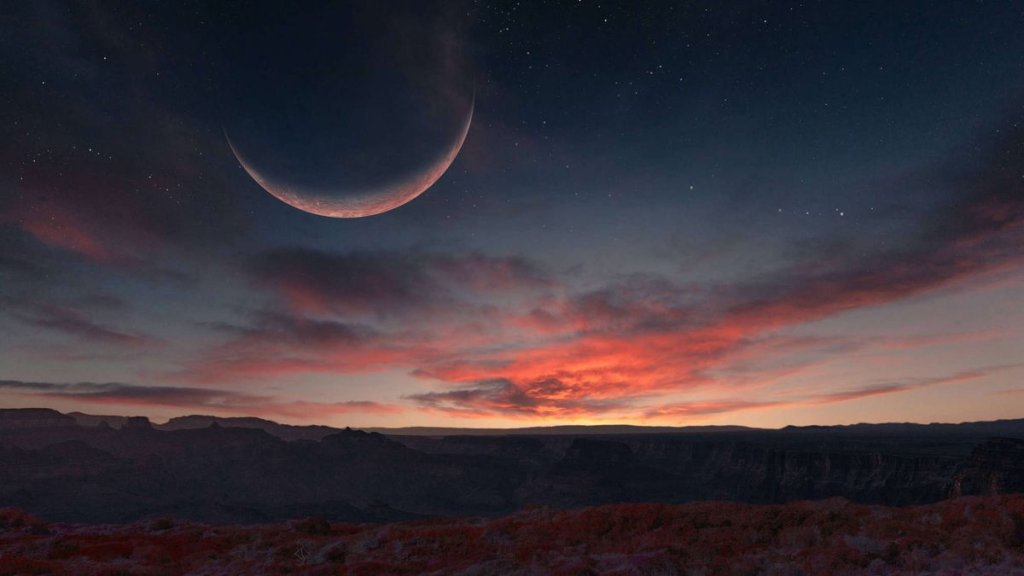New simulations that describe how moons, including Earth‘s own moon, formed strongly imply that exomoons are more likely to be found around rocky exoplanets.
Our moon is thought to have formed when a Mars-size planetesimal called Theia slammed into Earth, gouging out a huge wound in our planet and rendering its entire surface molten. It’s believed that the moon then coalesced from debris that settled into a ring around our planet.
Those are the generally accepted details, but the specifics are still hotly debated. The angle and velocity with which Theia struck Earth could change the scenario significantly, for instance. A more energetic impact would result in a moon-forming disk dominated by vapor, while a less energetic impact would have produced a disk dominated by silicate rock. Furthermore, whichever of those is the case would have a big impact on whether moons can form at all around a particular planet, according to new research that explores the consequences of something called a “streaming instability.”
Before you ask, no, streaming instability has nothing to do with when a show on your favorite streaming channel starts to buffer. Rather, a streaming instability describes how small particles in a vapor-rich disk around a planet are able to accrete into concentrations that rapidly form moonlets ranging in size from 10 yards (100 meters) to 62 miles (100 kilometers).
Related: Are they exomoons or not? Scientists debate existence of 1st moons seen beyond our solar system
Streaming instabilities are thus important in models of planet formation, but in simulations performed by a team led by Miki Nakajima of the University of Rochester, they could offer bad news for the survival of moons. According to the team’s calculations, the moonlets that streaming instabilities produce are not large enough to hold their own in a disk around a planet, and begin to feel a drag from friction with vapor in the region. This drag slows their orbital velocity and reduces the size of their orbit until they crash into their parent planet.
Therefore, these results suggest that a vapor-rich disk cannot build a natural satellite as large as our moon, which is 2,159 miles (3,475-kilometers) wide.. Instead, the various models that depict a more silicate-rich, vapor-poor disk, full of pebbles and chunks of rock ejected by a “gentler” impact, are more likely to result in the formation of a large moon.
This leads to a prediction regarding where we might find exomoons.
Collisions involving very large super-Earths or mini-Neptunes would likely be more energetic because of the stronger gravitational field associated with these worlds. Planets less than 1.6 times the size of Earth, however, would be more likely to produce a less energetic collision.
“Relatively small planets similar to the size of Earth are more difficult to observe and they have not been the major focus of the hunt for moons,” said Nakajima in a statement. “However, we predict these planets are actually better candidates to host moons.”
To date, no exomoons have definitely been found. There are a couple of candidates but these are hotly debated and really stretch the definition of “moon.” They are more like binary planets, such as a gas giant larger than Jupiter that’s partnered by a “satellite” the size of Neptune. The latter would be the “moon” in this case.
It should also be said that the large moons of the gas and ice giants in our solar system — namely of Jupiter, Saturn, Uranus and Neptune — were formed from objects such as giant comets that got too close to each respective planet and were ripped apart by the gravity of those planets before reassembling into a multitude of smaller objects. Moons around gas giants can’t form from impacts because, as we saw in 1994 with the impact of the fragments of comet Shoemaker–Levy 9 into Jupiter, any impactors would just get swallowed by the gaseous world.
Although moons are not necessary for life, our moon has undoubtedly had an influence on life on Earth. Its presence stabilizes our axial tilt and therefore our climate, while the tides it generates could have helped provide an environment for the origin of life, which some theories posit occurred in tidal pools.
The findings were published on June 17 in Planetary Science Journal.

